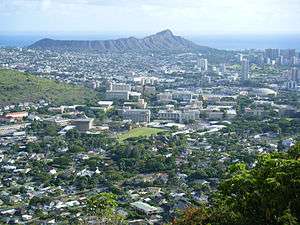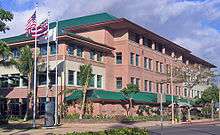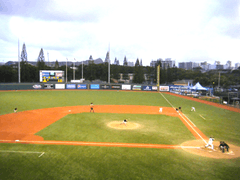University of Hawaii at Manoa
 | |
| Motto | "Ma luna a'e o na lahui a pau ke ola o ke kanaka" (Hawaiian) |
|---|---|
Motto in English | "Above all nations is humanity" |
| Type |
Public flagship Land-grant Sea-grant Space-grant |
| Established | 1907 |
| Endowment | $271.2 million (2016)[1] |
| Chancellor | Robert Bley-Vroman[2] |
| President | David Lassner |
| Students | 20,435 |
| Undergraduates | 13,952 |
| Postgraduates | 6,483 |
| Location |
Honolulu, Hawaii, U.S. 21°17′49″N 157°49′01″W / 21.297°N 157.817°WCoordinates: 21°17′49″N 157°49′01″W / 21.297°N 157.817°W |
| Campus | Urban, 320 acres (1.3 km2) |
| Colors |
Green, White[3][4] |
| Athletics |
NCAA - National Collegiate Athletic Association, Division I Big West (most sports); MW, MPSF |
| Nickname |
"Rainbow Warriors" (men) "Rainbow Wahine" (women) |
| Affiliations | |
| Website |
manoa |
 | |

The University of Hawaiʻi at Mānoa (also known as U.H. Mānoa, the University of Hawaiʻi, or simply U.H.) is a public co-educational research university as well as the flagship campus of the University of Hawaiʻi system. The school is located in Mānoa, an affluent neighborhood of Honolulu,[5] Honolulu County, Hawaiʻi, United States, approximately three miles east and inland from downtown Honolulu and one mile (1.6 km) from Ala Moana and Waikiki. The campus occupies the eastern half of the mouth of Mānoa Valley. The John A. Burns School of Medicine, part of the University of Hawai'i at Manoa, is located in Kaka'ako, adjacent to the Kaka'ako Waterfront Park. It is accredited by the Western Association of Schools and Colleges from the western mainland U.S. and is governed by the Hawaii State Legislature and a semi-autonomous board of regents, which in turn, hires a president to be administrator. This university campus also houses the main offices of the entire University of Hawaiʻi system.[6]
History
The University of Hawaiʻi at Mānoa was founded in 1907 as a land-grant college of agriculture and mechanical arts. A bill by Maui Representative William Coelho introduced into the Territorial Legislature March 1, 1907 and signed into law March 23rd by the Governor enabled construction to begin. In 1912 it was renamed the College of Hawaii and moved to its present location. William Kwai Fong Yap petitioned the Hawaii Territorial Legislature six years later for university status which led to another renaming finally to the University of Hawaii in 1920. This is also the founding year of the College of Arts and Sciences. In 1931 the Territorial Normal and Training School was absorbed into the University, becoming the U.H. College of Education.
College

Today, the primary facet of the university consists of the four Colleges of Arts and Sciences: Arts and Humanities, Languages, Literatures and Linguistics, Natural Sciences and Social Sciences. The college of agriculture and mechanical arts is now the College of Tropical Agriculture and Human Resources (CTAHR), one of the few agricultural colleges in the United States focused on the tropics. UH Mānoa is home to two of the state's most prominent professional schools. The William S. Richardson School of Law and the School of Medicine are the only law and medical schools in Hawaiʻi. It is also home to the Shidler College of Business which has the only AACSB accredited graduate business program in the state. It also has the only Doctor of Architecture program in the country. The Center for Hawaiian Studies provides 'excellence in the pursuit of knowledge concerning the Native people of Hawaii.[7]
Together, the colleges of the university offer bachelor's degrees in 93 fields of study, master's degrees in 84 fields, doctoral degrees in 51 fields, first professional degrees in 5 fields, post-baccalaureate degrees in 3 fields, 28 undergraduate certification programs and 29 graduate certification programs. Total enrollment in 2012 was 20,429 students, 14,402 of which are undergraduates. There are approximately sixteen students per instructor.
Research
With extramural grants and contracts of $436 million in 2012, research at UH-Mānoa relates to Hawaii's physical landscape, its people and their heritage. The geography facilitates advances in marine biology, oceanography, underwater robotic technology, astronomy, geology and geophysics, agriculture, aquaculture and tropical medicine. Its heritage, the people and its close ties to the Asian and Pacific region create a favorable environment for study and research in the arts, genetics, intercultural relations, linguistics, religion and philosophy.[8]
Extramural funding increased from $368 million in FY 2008 to nearly $436 million in FY 2012. Research grants increased from $278 million in FY 2008 to $317 million in FY 2012. Nonresearch awards totaled $119 million in FY 2012. Overall, extramural funding increased by 18%.[8][9]
The National Science Foundation ranked UH Manoa 45th among 395 public universities for Research and Development (R&D) expenditures in fiscal year 2014.[10]
For the period of July 1, 2012 to June 20, 2013, the School of Ocean and Earth Science and Technology (SOEST) received the largest amount of extramural funding among the Manoa units at $92 million. SOEST was followed by the medical school at $57 million, the College of Natural Sciences and the University of Hawai‘i Cancer Center at $24 million, the Institute for Astronomy at $22 million, CTARH at $18 million, and the College of Social Sciences and the College of Education at $16 million.[11]
Across the UH system, the majority of research funding comes from the Department of Health and Human Services, the Department of Defense, the Department of Education, the National Science Foundation, the Department of Commerce, and the National Aeronautics Space Administration (NASA). Local funding comes from Hawaii government agencies, non-profit organizations, health organizations and business and other interests.[11]
The $150-million medical complex in Kaka‘ako opened in the spring of 2005. The facility houses a state-of-the-art biomedical research and education center that attracts significant federal funding and private sector investment in biotechnology and cancer research and development.
Research (broadly conceived) is expected of every faculty member at UH Mānoa. Also, according to the Carnegie Foundation, UH Mānoa is an RU/VH (very high research activity) level research university.[12]
In 2013, UH Mānoa was elected to membership in the Association of Pacific Rim Universities, the leading consortium of research universities for the region. APRU represents 45 premier research universities—with a collective 2 million students and 120,000 faculty members—from 16 economies.[13]
Demographics
According to the 2010 report of the Institutional Research Office, a plurality of students at the University of Hawaiʻi at Mānoa are Caucasian making up twenty-five percent of the student body. Other backgrounds include Japanese Americans (13%) percent, native or part native Hawaiians (13%), Filipino Americans (8%) and Chinese Americans (7%). Twelve percent are racially mixed. Smaller populations of Pacific Islanders and other ethnic groups make up the balance.
Facilities
All UH Mānoa residence halls are coeducational. These include the Hale Aloha Complex, Johnson Hall, Hale Laulima, and Hale Kahawai. Suite-style residence halls include Frear Hall and Gateway House. First year undergraduates who choose to live on campus live in the traditional residence halls.[14]
Two apartment-style complexes are Hale Noelani and Hale Wainani. Hale Noelani consists of five three-story buildings and Hale Wainani has two high rise buildings (one 14-story and one 13-story) and two low rise buildings. Second year undergraduates and above are permitted to live in Hale Noelani and Hale Wainani.[14]
The university reserves some low rise units for graduate students and families.[15]
Academics
Colleges and schools

UH-Mānoa has 19 schools and colleges, including the School of Architecture, School of Earth Science and Technology, the College of Arts and Humanities, the Shidler College of Business, the College of Education and the College of Engineering. The College of Business Administration was renamed the Shidler College of Business on September 6, 2006, after real estate executive Jay Shidler, an alumnus of the college, who donated $25 million to the college.[16]
Honors Program
The UH-Manoa offers an Honors Program to provide additional resources for students preparing to apply to professional school programs.[17] Students complete core curriculum courses for their degrees in the Honors Program, maintain at least a cumulative 3.2 grade-point average in all courses, and complete a senior thesis project.[18]
Library
The University of Hawaii at Manoa Library, which provides access to 3.4 million volumes, 50,000 journals, and thousands of digitized documents, is one of the largest academic research libraries in the United States, ranking 86th in parent institution investment among 113 North American members of the Association of Research Libraries.[19]
Rankings
|
|
| ||||||||||||||||||||||||||||||||||||||||||||||||||||||||||||||||||||||||||||||||||||||||||
The National Science Foundation ranked UH Manoa 45th among 395 public universities for Research and Development (R&D) expenditures in fiscal year 2014.[10]
For 2017, UH Mānoa was ranked tied for 169th among national universities and tied for 89th among public universities in the U.S. by U.S. News & World Report.[30] In graduate school rankings for 2016, U.S. News & World Report ranked the School of Medicine tied for 19th in the country for primary care, the College of Education 76th, the Law School tied for 82nd, the School of Nursing tied for 83rd, the College of Engineering tied for 140th, with the Shidler College of Business' part-time MBA program ranked 140th in the nation.[30]
Distance learning
The university offers over 50 distance learning courses, using technology to replace either all or a portion of class instruction. Students interact with their instructors and peers from different locations to further develop their education.[31]
Student life
Student organizations
|
Off-campus
- The Newman Center / Catholic Campus Ministry serves the community at the University and surrounding area.
- The Lyon Arboretum is the only tropical arboretum belonging to any US University. The Arboretum, located in Mānoa Valley, was established in 1918 by the Hawaiian Sugar Planters' Association to demonstrate watershed restoration and test tree species for reforestation, as well as to collect living plants of economic value. In 1953, it became part of the University of Hawaiʻi at Mānoa. Its over 15,000 accessions focus primarily on the monocot families of palms, gingers, heliconias, bromeliads and aroids.
- The Waikiki Aquarium, founded in 1904, is the third-oldest public aquarium in the United States. A part of the University of Hawaiʻi since 1919, the Aquarium is located next to a living reef on the Waikiki shoreline.
Athletics



The University of Hawaiʻi at Mānoa competes in NCAA Division I, the only Hawaii school to do so. It competes in the Mountain West Conference for football only and the Big West Conference for most other sports.[33] UH competes in the Mountain Pacific Sports Federation in men’s volleyball, men’s and women’s swimming and diving, and indoor track and field while the coed and women’s sailing teams are members of the Pacific Coast Collegiate Sailing Conference.
Men’s teams are known as Rainbow Warriors, and women’s teams are called Rainbow Wahine. They are most notable for men's and women's basketball, volleyball, baseball and football programs. The University won the 2004 Intercollegiate Sailing Association National Championships. The women's volleyball program won NCAA championships in 1982, 1983 and 1987. The men's volleyball won an NCAA championship in 2002, but it was later vacated due to violations.
The principal sports venues are Aloha Stadium, Stan Sheriff Center, Les Murakami Stadium, Rainbow Wahine Softball Stadium, and the Duke Kahanamoku Aquatic Complex.
The university's athletic budget in FY 2008–2009 is $29.6 million.[34]
Chancellors
From 1986 to 2001, the President of the University of Hawaiʻi system also served as the Mānoa campus's chancellor. In 2001, the position of Chancellor was recreated[35] by then-UH president Evan Dobelle over conflict of interest concerns.
- Robert Bley-Vroman 2014–present interim
- Tom Apple 2012–2014
- Virginia Hinshaw 2007–2012
- Denise Konan 2005–2007 interim
- Peter Englert 2002–2005
- Deane Neubauer 2001–2002 interim[36]
- University president 1986–2002
- Kenneth P. Mortimer
- Albert J. Simone
Notable alumni and faculty
Notable alumni of the University of Hawaii at Manoa include oceanographer Bob Ballard (M.S. 1966), businessman Richard Parsons (B.A. 1968), congressman Mark Takai (B.A. 1989, M.P.H. 1991), and several U.S. Senators, including Daniel Akaka (B.A. 1952, M.Ed. 1966), Mazie Hirono (B.A. 1970), Tammy Duckworth (B.A. 1990), and Daniel Inouye (B.A. 1950). Additionally, both parents of the 44th U.S. president Barack Obama graduated from the university.
Controversies
In 2016 the UH Manoa Faculty Senate approved a resolution of no confidence in the Vice Chancellor for Academic Affairs, Reed Dasenbrock.[37][38]
In 2010, the university received criticism over its data policies after several high-profile data breaches.[39] In 1999, there was controversy within the Mānoa campus dealing with the accreditation of the School of Public Health.[40]
Art on campus
Campus art includes:
- The John Young Museum of Art
- The Jean Charlot collection at the Hamilton Library
- Murals by Jean Charlot: The Relation of Man and Nature in Old Hawaii (1949), Commencement (1953), Inspiration, Study, Creativity (1967), and Mayan Warrior (1970)
- Sculptures by Edward M. Brownlee: Maka ʻIo (Hawk’s Eye) (1984), and an untitled reflecting pool with copper and iron sculpture (1962)
- Sculptures by Bumpei Akaji: Maka ʻa e ʻIke Aku i ke Awawa Uluwehi i na Kuahiwi o Manoa (Glowing Eyes Looking at the Lush Valley in the Mountains of Manoa) (1979), Manaʻoʻiʻo (Confidence and Faith) (1981), and VVV (1995)
- Murals by Mataumu Toelupe Alisa: Backyard Cooking (1977), and Hula (1982)
- Works by Shige Yamada: ʻAlae a Hina (Mud Hen of Hina) (1977), and Rainbows (1997)
- Sculptures by Greg Clurman: Sumotori (Sumo Wrestler, 1975), and Hina o na Lani (Mother of the Universe, 1975)
- Wa (Harmony), ceramic sculpture by Wayne A. Miyata, 1982
- Founders’ Gate, stone arches by Ralph Fishbourne, 1933
- Neumes o Hawaiʻi, ceramic tile bench and planter by Suzi Pleyte Horan, 1976
- Chance Meeting, cast bronze sculpture by George Segal, 1991
- Three untitled murals by Frank M. Moore, 1919
- Silent Sound, brass bas relief by Paul Vanders, 1973
- The Net Effect, cast bronze sculpture by Fred H. Roster, 1982
- Rainbow Spirit, painted copper sculpture by Babs Miyano-Young, 1997
- Untitled ceramic wall sculpture by Isami Enomoto, 1964
- Gate of Hope, red-orange painted steel sculpture by Alexander Liberman, 1972
- Divers, red brass sculpture by Robert Stackhouse, 1991
- Krypton 1 x 6 x 18, mixed media monolith by Bruce Hopper, 1973
- Wisdom of the East, fresco by Affandi, 1967
- Pulelehua (Kamehameha Butterfly), ceramic mural by Bob Flint, 1986
- Makahiki Hoʻokupu (Harvest Celebration), charcoal and sanguine mural by Juliette May Fraser, 1938
- Nana i ke Kumu (Look to the Source), batik triptych by Yvonne Cheng, 1978
- GovDocs, mural by Judith Yamauchi, 1982
- ʻAnuenue #2 (Rainbow #2), three-part woven wall hanging by Reiko Brandon, 1977
- Seated Amida Buddha, 15th-century Japanese wood sculpture with gold over black lacquer
- Epitaph, bronze, steel and granite sculpture by Harold Tovish, 1970
- Grid/Scape, terrazzo and aluminum landscape sculpture by Mamoru Sato, 1982
- The Great Manoa Crack Seed Caper, by Lanny Little and student assistants, 1981
- The Bilger Frescoes representing Air, Water, Earth and Fire by Juliette May Fraser, David Asherman, Sueko Matsueda Kimura and Richard Lucier, 1951–1953
- The Fourth Sign, painted steel sculpture by Tony Smith, 1976
- Varney Circle Fountain, by Henry H. Rempel and Cornelia McIntyre Foley, 1934
- Spirit of Loyalty, cast glass sculpture Rick Mills, 1995
- Mind and Heart, metal sculpture by Frank Sheriff, 1995
- To the Nth Power, steel sculpture by Charles W. Watson, 1971
- Bamboo Forest, mural painted on bricks by Padraic Shigetani, 1978
- Peace Pole, painted obelisk, 1995
- Hawaiʻi Kaʻu Kumu (Hawai‘i My Teacher), pair of murals by Calley O'Neill and assistants, 1982
- Untitled painted photorealist mural by Donald Yatomi, 1990
- Arctic Portals, stainless steel sculpture by Jan-Peter Stern, 1975
- Adam, bronze sculpture by Satoru Abe, 1954
These artworks are off the main campus:
- East-West Center gallery
- Pleiades, overhead installation of mounted prisms at the Institute for Astronomy by Otto Piene, 1976
- Shadow of Progress mixed media sculpture at the Pacific Biomedical Research Center by Rebecca Steen, 1990
- Woven wall hanging at KHET (2350 Dole Street) by Jean Williams, 1972
Other points of interest
- Japanese garden with koi pond and teahouse
- The Sala, a Thai open pavilion
- Hawaii Peace Memorial, granite monument commemorates Japanese immigration to Hawai‘i
- Hawaii Warriors football
- Hawai`i Institute of Marine Biology
- Hawaii Ocean Time-series (HOT)
- The John Young Museum of Art
- Manoa Stream
- Haniwa, reproduction of a 3rd–7th century Yayoi period Japanese burial mound marker
References
- ↑ As of June 30, 2016. "U.S. and Canadian Institutions Listed by Fiscal Year (FY) 2016 Endowment Market Value and Change in Endowment Market Value from FY 2015 to FY 2016" (PDF). National Association of College and University Business Officers and Commonfund Institute. 2017.
- ↑ "Board of Regents approves interim chancellor for UH-Manoa". KHON2. Retrieved 30 January 2015.
- ↑ "University of Hawai‘i Graphics Standards". University of Hawai‘i. May 15, 2007. Retrieved June 13, 2015.
- ↑ "University of Hawai‘i at Manoa Catalog". University of Hawai‘i at Manoa. June 14, 2015. Retrieved June 14, 2015.
- ↑ "Honolulu CDP, HI Archived February 18, 2008, at the Wayback Machine.." U.S. Census Bureau. Retrieved on May 21, 2009.
- ↑ Magin, Janis L. "Land deals could breathe new life into Moiliili." Pacific Business News. Sunday July 1, 2007. 1. Retrieved on October 5, 2011.
- ↑ "Archived copy". Archived from the original on 2006-09-01. Retrieved 2006-09-12.
- 1 2 "UH Manoa: About UH Manoa: Facts & Statistics: Research". hawaii.edu. Retrieved 30 January 2015.
- ↑ "UH Manoa: About UH Manoa: Facts & Statistics: Research Awards". hawaii.edu. Retrieved 30 January 2015.
- 1 2 "Table 33. Higher education R&D expenditures at public institutions, ranked by all R&D expenditures, by source of funds: FY 2014". National Science Foundation. Retrieved November 24, 2015.
- 1 2 "2013 Annual Report Extramural Awards & Expenditures" (PDF). Ors.hawaii.edu. Retrieved 2016-08-17.
- ↑ "Carnegie Foundation, UH Manoa". Classifications.carnegiefoundation.org. Retrieved 2010-07-27.
- ↑ "Association of Pacific Rim Universities - Member Universities". Association of Pacific Rim Universities. Retrieved 30 January 2015.
- 1 2 "Archived copy". Archived from the original on 2011-06-04. Retrieved 2011-06-17.
- ↑ "Archived copy". Archived from the original on 2013-11-05. Retrieved 2014-07-25.
- ↑ "The Gift". Shidler.hawaii.edu. 2006-09-06. Retrieved 2010-07-27.
- ↑ "About Us - Honors Program". University of Hawaii at Manoa. Retrieved 19 June 2017.
- ↑ "Your Honors Journey". University of Hawaii at Manoa. Retrieved 19 June 2017.
- ↑
 "ARL Statistics 2007–2008". Retrieved 2013-01-25. (subscription required)
"ARL Statistics 2007–2008". Retrieved 2013-01-25. (subscription required) - ↑ "Academic Ranking of World Universities 2016: USA". Shanghai Ranking Consultancy. Retrieved August 16, 2016.
- ↑ "America's Top Colleges". Forbes. July 5, 2016.
- ↑ "Best Colleges 2017: National Universities Rankings". U.S. News & World Report. September 12, 2016.
- ↑ "2016 Rankings - National Universities". Washington Monthly. Retrieved September 6, 2016.
- ↑ "Academic Ranking of World Universities 2016". Shanghai Ranking Consultancy. 2016. Retrieved August 16, 2016.
- ↑ "QS World University Rankings® 2018". Quacquarelli Symonds Limited. 2017. Retrieved 25 July 2017.
- ↑ "World University Rankings 2016-17". THE Education Ltd. Retrieved September 21, 2016.
- ↑ "Best Global Universities Rankings: 2017". U.S. News & World Report LP. Retrieved October 25, 2016.
- ↑ "University of Hawaii—Manoa – U.S. News Best Grad School Rankings". U.S. News & World Report. Retrieved 10 August 2017.
- ↑ "University of Hawaii—Manoa – U.S. News Best Global University Rankings". U.S. News & World Report. Retrieved 10 August 2017.
- 1 2 "U.S. News Best Colleges Rankings". U.S. News & World Report. Retrieved November 18, 2015.
- ↑ "Distance Learning at the University of Hawai'i". University of Hawai'i. Retrieved December 9, 2015.
- ↑ "CTAHR - SOFT - Student Organic Farm Training". Ctahr.hawaii.edu. Retrieved 21 December 2015.
- ↑ Katz, Andy (December 10, 2010). "Hawaii joins MWC, Big West for 2012". ESPN.com. Retrieved January 20, 2011.
- ↑
- ↑ ftp://soest.hawaii.edu/dkarl/misc/dave/UH%26theSea/O-Chapter11.pdf
- ↑ "Mānoa: President Dobelle and Chancellor Neubauer to Address Students at Open Q&A Forum - University of Hawaii News". manoa.hawaii.edu. Retrieved 20 May 2017.
- ↑ "Manoa Faculty Senate | Minutes & Agendas | 2012-13". Hawaii.edu. Retrieved 2016-08-17.
- ↑ Kerr, Keoki. "UH Faculty Senate passes no confidence vote against executive accused of bullying, racism". Hawaiinewsnow.com. Retrieved 2016-08-17.
- ↑ "CRN Security News". CRN. Retrieved 29 May 2015.
- ↑ "Honolulu Star-Bulletin Local News". Archives.starbulleting.com. Retrieved 29 May 2015.
External links
 Media related to University of Hawaii at Manoa at Wikimedia Commons
Media related to University of Hawaii at Manoa at Wikimedia Commons- Official website
